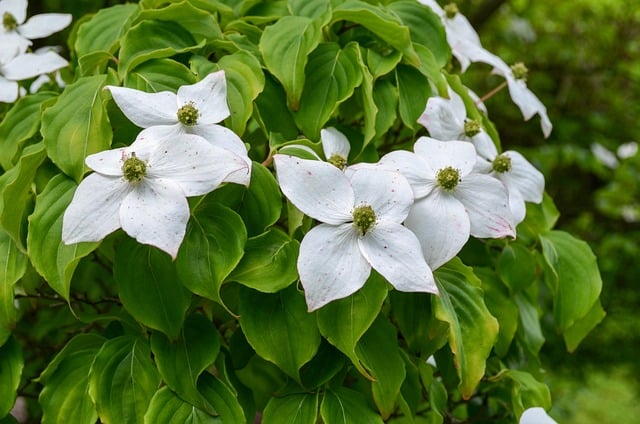Dogwood trees are a popular choice for homeowners and landscapers due to their beautiful blooms and attractive foliage. However, brown spots on dogwood leaves, could be a sign of a disease or other issue that needs attention.
Identifying the cause of brown spots on dogwood leaves is the first step in treating the problem and ensuring the health of your tree.
There are several common diseases that can cause brown spots on dogwood leaves, including fungal leaf spot, powdery mildew, and anthracnose. Each of these diseases has its own set of symptoms and effects on the tree, but all can lead to unsightly brown spots on the leaves.
In addition to disease, environmental factors such as drought or over-watering can also cause brown spots on dogwood leaves. Understanding the cause of the brown spots is key to determining the appropriate treatment and prevention strategies.
Key Takeaways
- Brown spots on dogwood leaves can be a sign of disease or environmental factors.
- Identifying the cause of brown spots is necessary for effective treatment and prevention.
- Proper care and maintenance can help prevent brown spots on dogwood leaves.
You shouldn’t miss on these other popular posts:
Identifying Brown Spots on Dogwood Leaves
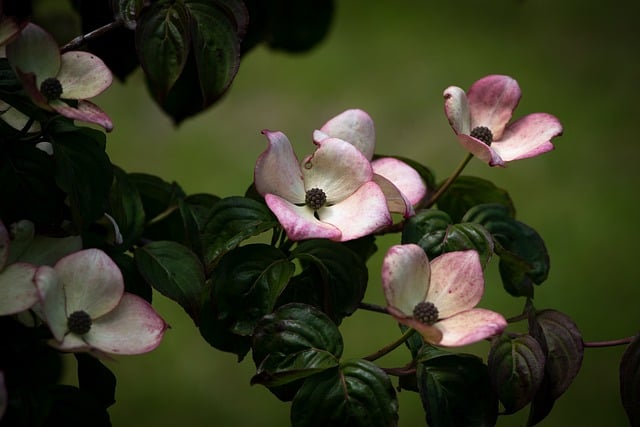
Dogwood trees are prone to various diseases that can cause brown spots on their leaves. Identifying the cause of the brown spots is the first step in treating the problem. Here are some common causes of brown spots on dogwood leaves:
- Septoria Leaf Spot: This fungal disease causes small brown spots on the leaves, which may have a yellow halo around them. The spots may merge to form larger dead areas on the leaves. The disease is most common in wet weather.
- Anthracnose: This fungal disease causes brown spots on the leaves, which may have a purple border around them. The spots may merge to form large dead areas on the leaves. The disease is most common in wet weather.
- Powdery Mildew: This fungal disease causes a white or gray powdery coating on the leaves, which may turn brown and die. The disease is most common in humid weather.
- Leaf Scorch: This is a non-infectious disease that can cause brown spots on the leaves. It occurs when the tree is stressed by drought, heat, or other environmental factors.
Diagnosing the cause of the brown spots is important for effective treatment. If you are unsure about the cause of the brown spots on your dogwood leaves, consult a professional arborist or horticulturist for a proper diagnosis.
In addition to the above diseases, there are other factors that can cause brown spots on dogwood leaves. These include insect damage, nutrient deficiencies, and physical damage. Examining the leaves closely and looking for other signs of damage can help in identifying the cause of the brown spots.
Overall, identifying the cause of brown spots on dogwood leaves is the first step in treating the problem. With proper diagnosis and treatment, you can help your dogwood tree recover and thrive.
Brown Spots on Dogwood Leaves – 4 Common Problems
Dogwoods are susceptible to a variety of diseases that can cause brown spots on their leaves. These diseases can be caused by fungi, bacteria, or environmental factors. In this section, we will discuss some of the most common diseases that cause brown spots on dogwood leaves.
1. Anthracnose
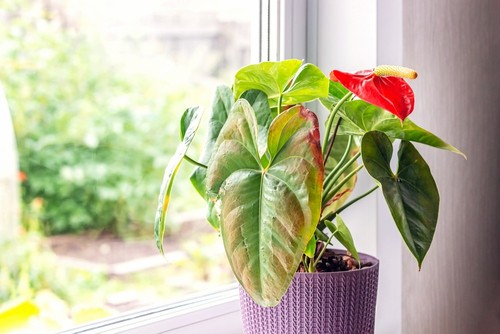
Anthracnose is a fungal disease that affects many trees, including dogwoods. It is caused by the fungus Discula destructiva and can cause brown spots on the leaves, as well as cankers on the trunk and branches. The disease is most common in wet, cool weather and can be spread by wind and rain.
To prevent anthracnose, it is important to keep the tree healthy and well-watered. Fertilizing the tree in the spring can also help prevent the disease. If the disease is present, infected leaves should be removed and destroyed to prevent the spread of the fungus.
2. Septoria Leaf Spot
Septoria leaf spot is another fungal disease that can cause brown spots on dogwood leaves. It is caused by the fungus Septoria cornicola and is most common in warm, humid weather. The disease can cause small, brown spots on the leaves that may have a yellow halo around them.
To prevent septoria leaf spot, it is important to keep the tree well-watered and remove any infected leaves. Fungicides can also be used to prevent the spread of the disease.
3. Powdery Mildew
Powdery mildew is a fungal disease that can cause a white or gray powdery coating on the leaves of dogwoods. It is caused by the fungus Erysiphe pulchra and is most common in warm, humid weather. The disease can cause brown spots on the leaves and can lead to defoliation if left untreated.
To prevent powdery mildew, it is important to keep the tree well-watered and remove any infected leaves. Fungicides can also be used to prevent the spread of the disease.
4. Other Diseases
In addition to anthracnose, septoria leaf spot, and powdery mildew, there are several other diseases that can cause brown spots on dogwood leaves. These include cercospora leaf spot, phyllosticta leaf spot, and dogwood anthracnose.
To prevent these diseases, it is important to keep the tree healthy and well-watered. Fungicides can also be used to prevent the spread of the diseases. If the diseases are present, infected leaves should be removed and destroyed to prevent the spread of the fungus.
Overall, it is important to keep dogwoods healthy and well-maintained to prevent the spread of fungal diseases that can cause brown spots on the leaves. By following proper care and maintenance techniques, dogwood trees can be kept healthy and free of disease.
Symptoms and Effects of Diseases
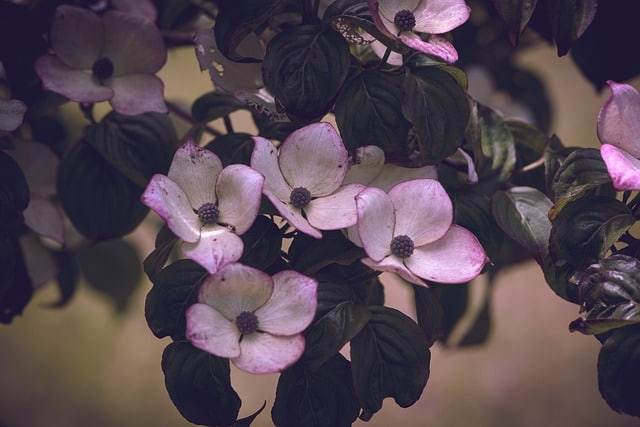
Dogwoods are susceptible to a variety of diseases that can cause brown spots on their leaves. These diseases can have a range of symptoms and effects, depending on the specific disease and its severity.
One common disease that causes brown spots on dogwood leaves is anthracnose. This fungal disease can cause brown blotches on the leaves, as well as twig dieback and crown cankers.
In severe cases, it can lead to defoliation and decline of the tree. Anthracnose is most common in wet spring weather, when the spores are spread by rain.
Another disease that can cause brown spots on dogwood leaves is powdery mildew. This fungal disease typically appears as a white or gray powdery coating on the leaves, stems, and flower bracts.
It can cause yellowing and scorching of the leaves, as well as stunted growth and water sprouts. Powdery mildew is most common in warm, dry weather, when the spores are spread by wind.
Dogwoods can also be affected by dogwood blight, a bacterial disease that can cause purple blotches on the leaves and twig dieback. This disease is most common in warm, wet weather, and can lead to defoliation and branch dieback if left untreated.
Other diseases that can cause brown spots on dogwood leaves include fungal leaf spot, which can cause angular lesions on the leaves, and winter injury, which can cause brown leaves and branch dieback. Drought stress and winter injury can also cause brown leaves on dogwoods.
Overall, it is important to monitor dogwoods for signs of disease and take appropriate measures to prevent and treat them. This can include proper watering and fertilization, as well as pruning and removal of infected branches.
If you suspect that your dogwood is infected with a disease, it is important to consult with a professional arborist or horticulturist for proper diagnosis and treatment.
Treatment and Prevention Strategies
1. Using Fungicides

Fungicides are an effective way to control leaf spot diseases caused by fungal pathogens. Gardeners can use fungicides containing propiconazole, myclobutanil, triadimefon, thiophanate methyl, sulfur, or copper to control the spread of fungal spores.
It is important to follow the instructions on the product label and apply the fungicide at the right time to achieve maximum effectiveness.
2. Pruning and Air Circulation
Pruning and air circulation are important in preventing and controlling leaf spot diseases. Pruning removes infected leaves, branches, and flowers, which helps to reduce the spread of the disease.
Proper pruning techniques also promote air circulation, which helps to reduce the humidity that favors fungal growth. Gardeners should aim to prune dogwoods during the dormant season, which is usually in late fall or winter.
3. Proper Watering and Fertilization
Proper watering and fertilization are essential in keeping dogwoods healthy and resistant to leaf spot diseases. Overwatering can lead to root rot, which weakens the tree and makes it more susceptible to diseases.
Gardeners should water dogwoods deeply and infrequently, rather than shallowly and frequently. They should also avoid overhead irrigation, which can promote the growth of fungal spores.
Fertilization should be done in the spring and fall, using a balanced fertilizer that contains equal amounts of nitrogen, phosphorus, and potassium.
4. Choosing Resistant Cultivars
Choosing resistant cultivars is an effective way to prevent and control leaf spot diseases. Gardeners should choose cultivars that are resistant to the specific leaf spot disease that is prevalent in their area.
For example, the Kousa dogwood is resistant to dogwood anthracnose, while the Cornelian cherry dogwood is resistant to powdery mildew. Gardeners should also choose cultivars that are adapted to their local climate and soil conditions.
In addition to these strategies, gardeners should also practice good sanitation by raking and disposing of infected leaves and debris. They should also monitor for pests such as aphids and dogwood borers, which can weaken the tree and make it more susceptible to diseases.
Lastly, gardeners should provide dogwoods with the right amount of sunlight and partial shade, and mulch around the base of the tree to protect it from cold temperatures.
Dogwood Varieties and Their Susceptibility
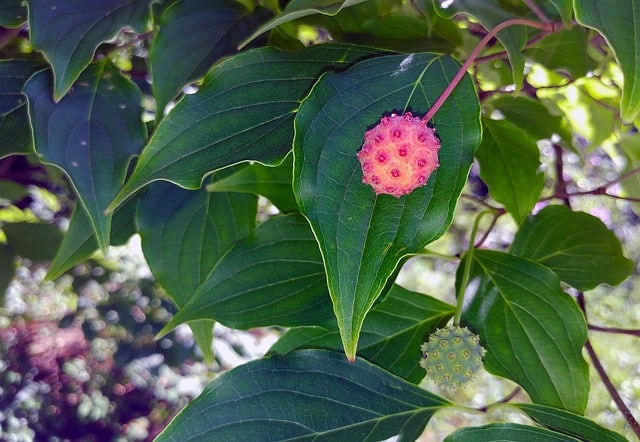
Dogwoods are popular ornamental trees that come in various varieties. Some of the most common dogwood varieties are the Cornus florida, Cornus kousa, and Cornus nuttallii. Each variety has unique characteristics that make them popular among gardeners and landscapers.
When it comes to susceptibility to leaf spots, some dogwood varieties are more resistant than others. For instance, the Cornus kousa variety is known to be more resistant to leaf spots than the Cornus florida. This is because the Cornus kousa has thicker leaves that are more resistant to fungal infections.
Another variety that is known for its resistance to leaf spots is the Cornus nuttallii. This variety is native to the western United States and is known for its large, white flowers that bloom in the spring. The Cornus nuttallii is also resistant to powdery mildew, which is a common fungal infection that affects dogwood trees.
In contrast, the Cornus florida is more susceptible to leaf spots, especially the dogwood anthracnose and spot anthracnose. These diseases can cause brown spots on the leaves, which can eventually lead to defoliation if left untreated.
However, there are disease-resistant varieties of Cornus florida, such as the ‘Appalachian Spring’, that are less susceptible to leaf spots.
Overall, it is important to choose the right dogwood variety based on its resistance to leaf spots and other diseases. Gardeners and landscapers should also follow proper care and maintenance practices to keep their dogwood trees healthy and resistant to leaf spots.
This includes regular watering, pruning, and fertilization, as well as avoiding overhead irrigation and planting in well-drained soil.
Conclusion
Dogwood leaves can develop brown spots due to various reasons, including fungal infections, overwatering, and environmental stress. It is essential to identify the underlying cause of the problem to implement the appropriate solution.
One of the most common fungal infections that cause brown spots on dogwood leaves is Elsinoe Leaf Spot. It is favored by wet spring weather and can cause leaves and flower bracts to become wrinkled and distorted. However, it is not a severe disease and can be managed by removing infected leaves and applying fungicides.
Another fungal disease that causes brown spots on dogwood leaves is Septoria Leaf Spot. It causes angular, brown lesions bordered by a purplish color on the leaf, and may result in early leaf drop. However, it does not infect the twigs or branches and is less damaging than dogwood anthracnose.
Overwatering can also cause brown spots on dogwood leaves. Dogwoods do not like to be overwatered, and if their base stands in water, they can eventually start to rot, causing their leaves to turn brown. Dogwoods should only be watered semi-liberally and daily for the first 7-10 days after planting.
Environmental stressors, such as drought, heat, and poor soil conditions, can also cause brown spots on dogwood leaves. It is essential to maintain proper watering and fertilization practices to prevent environmental stress.
In conclusion, identifying the underlying cause of brown spots on dogwood leaves is crucial to implementing the appropriate solution. By following proper watering, fertilization, and disease management practices, dogwood owners can keep their trees healthy and beautiful.
Frequently Asked Questions
How can I treat dogwood anthracnose?
Dogwood anthracnose is a fungal disease that affects dogwood trees. The best way to treat it is to prune the infected branches and leaves, and to apply a fungicide to the tree.
It is important to remove and dispose of any dead or dying twigs or branches found in the tree, as well as leaves that show the symptoms of dogwood anthracnose. Fungicides containing chlorothalonil or copper are effective in treating the disease.
What causes purple spots on dogwood leaves?
Purple spots on dogwood leaves are usually caused by a fungal disease called powdery mildew. This disease is caused by a fungus that grows on the surface of the leaves, causing them to turn purple.
The best way to prevent powdery mildew is to keep the tree well-watered and to prune it regularly. Fungicides containing sulfur or potassium bicarbonate can be used to treat powdery mildew.
What fungicide is effective for dogwood trees?
Fungicides containing chlorothalonil or copper are effective in treating fungal diseases in dogwood trees. These fungicides can be applied as a spray to the tree, and should be used according to the manufacturer’s instructions.
It is important to follow the instructions carefully, as overuse of fungicides can damage the tree.
What causes brown spots on dogwood flowers?
Brown spots on dogwood flowers are usually caused by a fungal disease called spot anthracnose. This disease is caused by a fungus that grows on the surface of the flowers, causing them to turn brown.
The best way to prevent spot anthracnose is to keep the tree well-watered and to prune it regularly. Fungicides containing chlorothalonil or copper can be used to treat spot anthracnose.
What is the difference between spot anthracnose and dogwood anthracnose?
Spot anthracnose and dogwood anthracnose are both fungal diseases that affect dogwood trees, but they are caused by different fungi.
Spot anthracnose is caused by the fungus Discula destructiva, while dogwood anthracnose is caused by the fungus Apiognomonia errabunda. The symptoms of the two diseases are similar, but dogwood anthracnose is usually more severe.
How can I get rid of spots on my dogwood leaves?
The best way to get rid of spots on dogwood leaves is to prune the infected branches and leaves, and to apply a fungicide to the tree. Fungicides containing chlorothalonil or copper are effective in treating fungal diseases in dogwood trees.
It is important to remove and dispose of any dead or dying twigs or branches found in the tree, as well as leaves that show the symptoms of the disease.

Hey, I’m Lisa and I’ve been an avid gardener for over 30 years. I love writing, talking and living in the garden! Feel free to connect with me on my socials below

